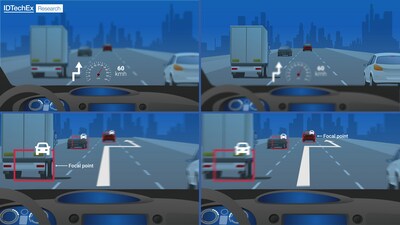BOSTON, April 17, 2024 /PRNewswire/ — Automotive heads-up displays (HUDs) are currently being met with great enthusiasm and expectations. The increased usage of technology while driving and with drivers having to deviate their gaze from the road to look at the dashboard and center information displays (CID) in vehicles have resulted in more road accidents over the years. Drivers must deviate their gaze from the road to look at on-board diagnostics (OBDs), check the GPS, select music, and so on. HUDs present these images directly in the driver’s line of sight, thus reducing the need for the driver to look away from the road.
This need helps increase road safety, making the automotive industry consider HUDs a viable option to reduce driver distraction.
The IDTechEx report, “Automotive Heads-up Displays 2024-2034: Technologies, Players, Opportunities“, provides a comprehensive coverage of this space, from the most renowned 2-dimensional technologies to the more futuristic 3-dimensional imaging techniques that are set to revolutionize the automotive sector. The report also covers key trends, market analysis, opportunities, and granular 10-year forecasts for display volume (number of displays) and value (US$), segmenting the industry by display type, technology, and region.
The current dominant technology in this space is TFT-LCD, providing good image quality, durability, and maturity. Most importantly, it is also very scalable and comparably inexpensive when compared with alternatives in the market. It is, however, 2-dimensional and lacks depth when signaling objects on the road when used as a HUD. More than just displaying OBDs and car information, it is envisioned HUDs will be able to signal potential hazards on the road and further assist drivers while driving. These are also known as augmented reality HUDs (AR-HUDs). Due to this increased immersiveness, it is important to have a technology that provides depth to the images and extended field of view (FOV) while signaling key areas of interest on the road.
There are two technologies that can enable three-dimensional imaging and are being experimented on HUDs: computer-generated holography (CGH) and light field displays (LFDs).
Unlike two-dimensional displays or stereoscopic displays, these 3D technologies project virtual objects with true depth cues. LCDs, OLEDs, and microLEDs are all examples of 2D technologies that display images directly onto a flat surface. At times, they are used to create an illusion of 3D images, where a 2D image is shown to the left eye and a slightly different image is shown to the right eye. This is known as a parallax effect. However, the extended use of these 2D techniques to display 3D images induces an effect known as vergence-accommodation conflict (VAC). VAC is the disparity in distances between the virtual object and the eye. Say, for instance, a virtual object is displayed 3m from the eye, but the eye naturally focuses on a screen a few centimetres from the eye. This distance mismatch causes user discomfort and nausea, meaning users cannot use these stereoscopic displays for too long.
Several companies and research groups are therefore evaluating the use of 3D display technologies such as holography and LFDs.
Holography, in particular, appears to be gaining more attraction when applied to automotive HUDs, and there are some notable reasons for this increased interest.
The first was addressed earlier and relates to its ability to project virtual images with true depth cues and without a loss in resolution. The driver experience is significantly more comfortable when road obstacles are signaled by images that have depth. Much like our everyday vision, we are able to seamlessly focus and defocus on virtual objects, something that is not easily achievable using 2D technologies. The varying depth cues offer a more comfortable driving experience for the driver and can become more helpful with signaling road obstacles that naturally have varying depths.
Secondly, brightness is fundamentally important in HUDs. A display technology that works well under varied ambient conditions is essential, as key information must be visible in very bright or dark conditions. CGH uses a coherent light source, and this is most often a laser. Lasers are naturally very bright and perform consistently under a wide range of ambient light environments.
Companies specializing in holographic HUDs are focusing on two key areas to compete with the dominant TFT-LCD technology: lowering the cost of these devices and reducing their form factor. Currently, larger form factors and increased cost mean these devices are only suitable for larger, more expensive vehicles, also known as premium vehicles. In order to become more competitive in this market and benefit from the large market potential, cost and form factors must decrease.
While holographic technology is considered suitable for automotive HUDs, the comparatively poorer image quality when compared to LCDs and OLEDs, mainly due to an effect known as speckle, means that it requires further maturity to be adopted in other applications in the long term.
IDTechEx’s “Automotive Heads-up Displays 2024-2034: Technologies, Players, Opportunities” report analyses the main technologies and HUD types being developed and expected to grow over the next decade. The challenge in developing automotive HUDs is more than just ensuring the technology works accordingly; it must comply with the very stringent regulations the sector demands. This report covers key innovations in manufacturing as well as coating requirements to enhance the performance of HUDs.
To find out more about this IDTechEx report, including downloadable sample pages, please visit www.IDTechEx.com/AutoHUD.
For the full portfolio of market research available from IDTechEx, please visit www.IDTechEx.com.
About IDTechEx:
IDTechEx provides trusted independent research on emerging technologies and their markets. Since 1999, we have been helping our clients to understand new technologies, their supply chains, market requirements, opportunities and forecasts. For more information, contact research@IDTechEx.com or visit www.IDTechEx.com.
Images download:
https://www.dropbox.com/scl/fo/eww0x79mn0bvxo68p936n/h?rlkey=jmhg5c35wwvqi4wu33m1t6k8l&dl=0
Media Contact:
Lucy Rogers
Sales and Marketing Administrator
press@IDTechEx.com
+44(0)1223 812300
Social Media Links:
Twitter: www.twitter.com/IDTechEx
LinkedIn: www.linkedin.com/company/IDTechEx
Photo – https://mma.prnewswire.com/media/2386753/IDTechEx.jpg
Logo – https://mma.prnewswire.com/media/478371/IDTechEx_Logo.jpg
![]() View original content to download multimedia:https://www.prnewswire.com/news-releases/idtechex-explores-the-potential-of-holographic-projections-in-automotive-heads-up-displays-302116558.html
View original content to download multimedia:https://www.prnewswire.com/news-releases/idtechex-explores-the-potential-of-holographic-projections-in-automotive-heads-up-displays-302116558.html
SOURCE IDTechEx

Featured image: I Stock © Khanchit Khirisutchalual….





